#186: The Genus Cortinarius
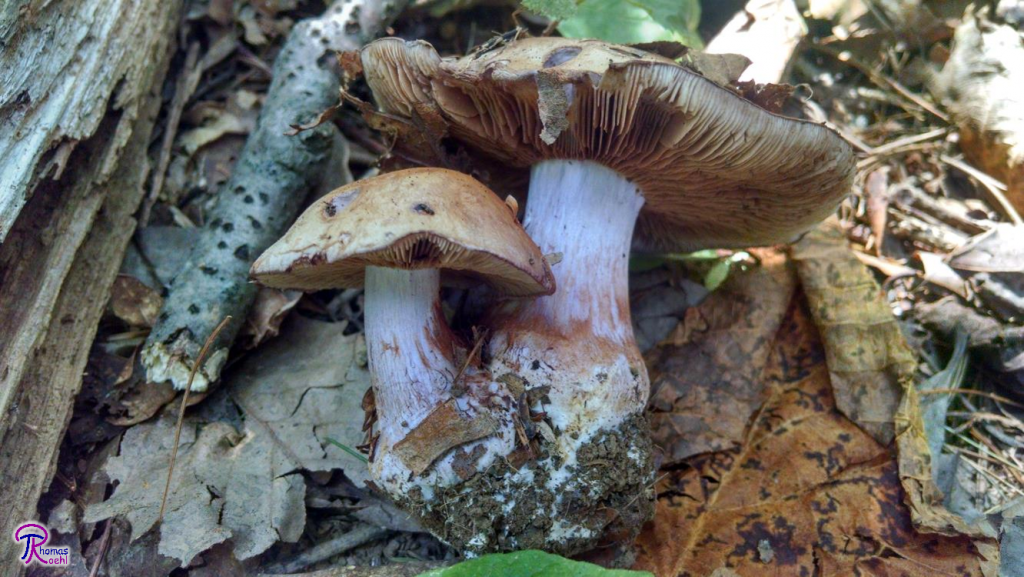
This Cortinarius sp. has remnants of a cobweb-like partial veil that are colored brown by spores, as is typical of the genus.
Cortinarius contains umbrella-like agaric mushrooms that are mycorrhizal, have a brown spore print, and produce a cobweb-like partial veil. It is the largest mushroom genus on Earth, with over two thousand species crammed into it. While the genus itself is fairly easy to recognize, identifying anything down to species is next to impossible. Most of the species listed in field guides are actually species groups and the field guide descriptions apply to a handful of closely related species.1,2
Description
Mushrooms in the genus Cortinarius (often called ‘webcaps’ or ‘corts’) usually display three features that make them stand out from other gilled mushrooms: they have a medium brown spore print, they have a cobweb-like partial veil, and they grow on the ground near trees. Like most agaric mushrooms, webcaps have a circular pileus with gills underneath that radiate out from a central stipe.1–3 The stipe often ends with a distinctly enlarged base, but this is not particularly useful for identification to genus.4
The most distinctive feature of Cortinarius is found partway up the stipe and sometimes on the pileus margin. Mature webcaps usually have a ring of cobweb-like tissue and some may still have some wispy filaments hanging off the margin. These tangles of threads are the remains of a partial veil that once covered extended from the stipe to the margin and served to protect the developing gills. Most other families of agarics have partial veils that are membranous, that is, the tissue is thick and coherent; species of Amanita (FFF#172), for example, often have thick partial veils that in maturity remain hanging off the stipe like a skirt. Instead of this, webcaps have what mycologists call a ‘cortina’: a partial veil composed of loose threads that resembles a cobweb or spider web. The best time to see this feature is when the mushrooms are still young, so collecting a few mushrooms at different developmental stages will greatly improve your chances of recognizing it as a Cortinarius.1–3
In mature specimens that have a ring, it is usually very easy to see the spore print color. The cortina is very good at catching spores and becomes completely covered in brown spores by maturity. Webcaps have a rusty-brown spore print, a characteristic that varies little across the genus. If you can’t see any spores caught in the cortina, try looking at the gills of a mature specimen. As corts age, their gills tend to take on a brownish hue thanks to the buildup of mature spores. Of course, taking a spore print is still the best way of assessing spore color. Under the microscope, the spores are darkly pigmented, have a rough to bumpy texture, and lack an germ pore.1–3
Finally, Cortinarius species are ectomycorrhizal with pines, beeches, oaks, willows, poplars, cottonwoods, and relatives of those trees. As a result, corts fruit only on the ground underneath trees. Since they grow with both hardwoods and conifers, you can find webcaps in nearly every forest in the world.1–3
Identifying to Species
So you want to identify your Cortinarius down to species? Other than sending it off for DNA testing, your best strategy may be to dry the mushroom, seal it in a mason jar, and try again after 30 years. By that time, mycologists might have catalogued most of the species and created a definitive guide to the genus. Right now, the best field guides take you only as far as species groups and do not cover the genus extensively.1 At the 2016 North American Mycological Association annual foray, one collection of a C. alboviolaceus-like species resisted all attempts at identification from the 30 or so professional mycologists on hand; presumably this species was later identified by DNA or by consulting an obscure journal article, neither of which are readily available to the average mushroom hunter.
If you do want to attempt to put the correct name to your species, you should make a note of all your mushroom’s characteristics. In particular, pay attention to the following features: what trees are nearby, what color the gills are when young, how slimy the cap and stem are, whether the mushroom changes color as it dries out (‘hygrophanous’), all morphological features of the stipe (taking detailed pictures of the stipe will help here), whether your specimen has any distinctive odors (or flavors, if you’re positive you don’t have a poisonous mushroom), and any changes in color when potassium hydroxide or Melzer’s reagent is applied. You’ll probably also need to examine the mushroom’s gill and pileus tissues under a microscope to check the features of the spores, cystidia, and whether the hyphae have clamp connections.1,2
Edibility and Uses
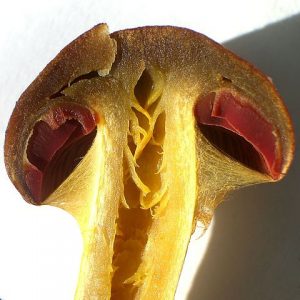
This young Cortinarius semisanguineus has been cut in half to show the young cortina. Photo by Jason Hollinger [CC BY 2.0], via Wikimedia Commons
However, people interested in dyeing with mushrooms (FFF#159) should brush up on their webcap identification skills. Mushrooms like C. semisanguineus and its relatives are prized for the brilliant red dyes they produce. You don’t often find very many of these mushrooms, but that’s OK because the pigments are often so concentrated that their dyeing ability is undiminished for five or more cycles!
Taxonomy
As if Cortinarius identification wasn’t already hard enough, DNA analysis seems to have turned taxonomy within the genus into a big mess. Cortinarius used to be split into several subgenera based on shared morphological characteristics. However, DNA evidence showed that many of those subgenera were polyphyletic. Most field guides will probably continue to use those old groups as handy ways to narrow down identification, but the majority of them will no longer align with taxonomy. Perhaps surprisingly, DNA seems to support Cortinarius as a large, bloated genus. Within the genus, however, mushrooms split off into around 30 lineages (and likely more, since many species remain unsampled) that taxonomists have yet to completely nail down.2
| Kingdom | Fungi |
| Division | Basidiomycota |
| Subdivision | Agaricomycotina |
| Class | Agaricomycetes |
| Subclass | Agaricomycetidae |
| Order | Agaricales |
| Family | Cortinariaceae |
| Genus | Cortinarius (Pers.) Gray6 |
This post describes a group of mushrooms and as such the information on this page (including the pictures) cannot be used to identify any mushroom in particular.
This post does not contain enough information to positively identify any mushroom. When collecting for the table, always use a local field guide to identify your mushrooms down to species. If you need a quality, free field guide to North American mushrooms, I recommend Michael Kuo’s MushroomExpert.com. Remember: when in doubt, throw it out!
See Further:
http://www.mushroomexpert.com/cortinarius.html
http://www.svims.ca/council/Cortin.htm
Citations
- Kuo, M. The Genus Cortinarius. MushroomExpert.Com (2011). Available at: http://www.mushroomexpert.com/cortinarius.html. (Accessed: 28th April 2017)
- Gibson, I. Notes on CORTINARIUS in the Pacific Northwest. Pacific Northwest Key Council (2017). Available at: http://www.svims.ca/council/Cortin.htm. (Accessed: 28th April 2017)
- Volk, T. J. Tom Volk’s Fungus of the Month for September 1999. Tom Volk’s Fungi (1999). Available at: http://botit.botany.wisc.edu/toms_fungi/sept99.html. (Accessed: 28th April 2017)
- Cortinarius Genus. Great Lakes Nexus Page of Mushroom, The Journal of Wild Mushrooming Available at: http://www.mushroomthejournal.com/greatlakesdata/Taxa/CortiGenus42.html. (Accessed: 28th April 2017)
- Miller, O. K. & Miller, H. North American mushrooms: a field guide to edible and inedible fungi. (Falcon Guide, 2006).
- Cortinarius. Mycobank Available at: http://www.mycobank.org/Biolomics.aspx?Table=Mycobank&Rec=56348&Fields=All. (Accessed: 28th April 2017)

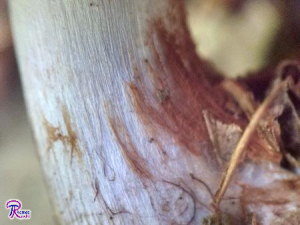

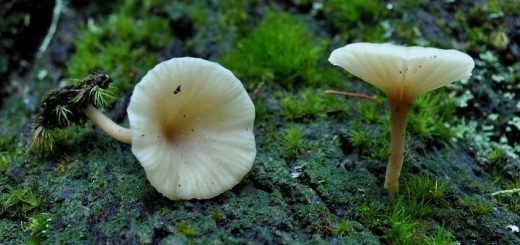
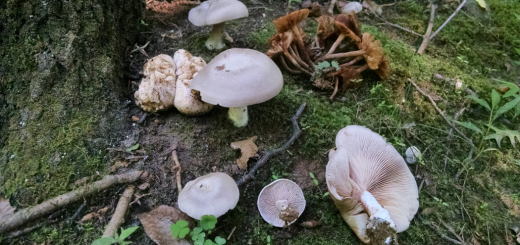





![#011: Characteristics of Kingdom Fungi [Archived]](https://www.fungusfactfriday.com/wp-content/themes/hueman/assets/front/img/thumb-small-empty.png)

3 Responses
[…] Cortinarius22-24 […]
[…] well suited for beginner foragers. The most problematic of these are species of Cortinarius (see FFF#186). Cortinarius mushrooms tend to have a similar shape and stature to Blewits and there are many that […]
[…] well suited for beginner foragers. The most problematic of these are species of Cortinarius (see FFF#186). Cortinarius mushrooms tend to have a similar shape and stature to Blewits and there are many that […]